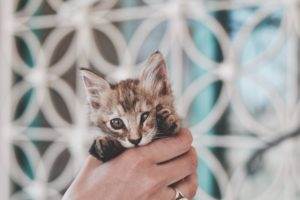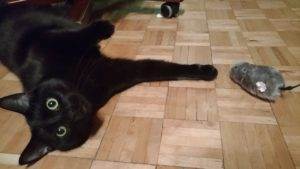






The day has come. The decision has been made. There will soon be a mini tiger on the loose in your house. Is this your first cat? You must have a million questions. Fortunately, we’ve prepared some of the most important answers for you in a nutshell 🙂
First of all, don’t expect that this great individualist will perfectly take care of itself. Before you take this sweet kitten home with you…
DO YOUR HOMEWORK
‘Impulse buying’ a pair of jeans is one thing, and buying a live animal is another. There’s no return option if something goes wrong, or if you suddenly change your mind. A new pet is a new member of the family and, before you bring it home, you need to consider all the pros and cons, gain basic information about the differences between breeds as well as about cat behavior and basic care. The more you know about your cat, the better.
Before you welcome your new friend into your home, it’s worth considering some improvements to your home and to your everyday life.
Food – although a cat is a highly intelligent animal, it has no idea what it can and can’t eat. But its appetite is always quite unsatisfied. Also, keep in mind that some delicacies, such as chocolate, grapes, raisins, or even dairy products, may give cats stomachaches, make them bleed or even die.
Plants – you should stop your cat from gnawing at or eating potted plants as well as those growing in the garden, because some of them may do it harm. These include the popular lilies, oleanders, and tulips.
Medicines and household chemicals – they can’t just lie on the floor, on the table, or wherever your cat can get (and believe us, it can get in many places). This includes any dietary products or non-chemical cleaning products.
Electronics – your furball feels best in warm places. So, watch any devices that heat up, such as laptops. Some good solutions to this problem are a special bed hanging from a radiator (in winter) or a special heated mat for cats. By the way, make sure that there are no plugged-in electric cables hanging or lying around, which could tempt your predator.

YOUR 10-POINT LIST BEFORE BUYING/ADOPTING A CAT
Animal shelter – if you can, first check if it would be possible to adopt from a nearby shelter. Just think about making some homeless pet happy and giving it a home – it will be grateful to you for the rest of its life.
Breed – do you want a purebred? Make sure that your favorite breed is right for you. A purebred cat often needs proper feeding, care, and attention (for example, a Persian cat needs daily grooming and regular baths, and a Norwegian forest cat needs a pen – preferably in the garden).
Castration/spaying – this should be done when your kitten is still young, usually after it turns 8 weeks old. The number of cats in shelters is already terrifying, so, unless you plan on starting a cattery, have this procedure performed early on.
Good to know: neutered cats are less aggressive, more trusting, and hold a smaller territory, which, in the case of cats that go outside, reduces the risk of an accident or fighting with other cats. Afterwards, females don’t go into heat, and males stop marking their territory at home. What’s more, cats that have been neutered usually live longer than those that haven’t, are less stressed, and more balanced.
Vaccines – remember that even a healthy cat requires visits to the vet. Vaccination once a year, and ‘worming’ 2–4 times a year. In the first year of your kitten’s life, you’ll need to have it wormed and vaccinated twice. The most common diseases and viruses against which vaccinations are recommended include: rabies, feline viral rhinotracheitis (FVR), the feline calicivirus (FCV), the feline panleukopenia virus (FPLV), and leukemia.
Microchipping – currently, in Poland there’s no obligation to microchip cats. Many cat owners microchip their pets for their safety – to be able to find them more easily in case they ever get lost. Microchipping is a one-time procedure, lasts for the whole life of the animal, and costs from PLN 40 to PLN 80 depending on town and clinic. Many cities organize periodic microchipping campaigns free of charge.
Parasites – while fleas, ticks, and worms are widely known, there are many more parasites to look out for, such as ear mites, or the parasites that cause toxoplasmosis.
Good to know: to avoid any unpleasant surprises, you should schedule checkups at the local vet’s office every year.
Litter box – to every cat, the toilet is sacred. Put the litter box in a quiet, secluded place, and invest in good litter (in stores, you’ll find several different types. The litter from the Pinokio series by Comfy does a very good job – it’s a 100% natural wood litter. It’s easy to use, doesn’t stick to paws, and is environmentally friendly. Also, it can be flushed down the toilet, which, for some people, may prove to be a real help in cleaning). As far as ‘cat toilets’ are concerned, we recommend a litter box from the Cleo Medium series by Comfy – it has a detachable rim that helps to keep the box clean and prevents the litter and waste from spilling out of the box. And remember – if your tiger happens to urinate outside the litter box, it usually means that… you haven’t cleaned it! If the box is clean and the cat still pees outside it, make sure to take it to the vet.
Toys, toys, toys – most cats are fun, curious, and need people’s attention. An ordinary shoebox and some old shoelaces may be enough for starters, but you’ll certainly need more than that to meet this fountain of inexhaustible energy. There are a few things that will do a great job with this, such as teaser wands (e.g. the Gaia series by Comfy – cat teaser wands made of environmentally friendly materials), rustling toys with fluffy tails (e.g. WOW – a toy with a bell that encourages play), squeaky mice (e.g. the Catch me wind-up toy), etc.
Good to know: a must-have gadget is a scratcher (e.g. the Jack multi-level cat tree for active cats, with a shelter, by Comfy), which not only provides a lot of fun (climbing, playing, going nuts), but also allows to sharpen claws. If you don’t have one at your home, prepare for furniture damage.

Food – cats, being the tigers that they are, are carnivorous animals. The wheat and corn in the food are just fillers that cats don’t need and will have difficulty digesting. Cheap foods also contain very harmful chemical substances and addictive sugar. Invest in good quality food that’s still within your budget – this will save you frequent and expensive visits to the vet’s office later on.
Harnesses, collars, and cages – walking cats on leashes is not that popular, but a collar or, better yet, a harness will come in handy when your cat doesn’t know its surroundings well yet or when it may have a tendency to run away (for example, if it gets scared of something). A cage/carrier is still the only safe way to transport your kitty when you’re setting out on a journey together – Comfy Happy Pet or Bella trio N will be great for this – these are 3-in-1 carriers for dogs and cats. A carrier, a shelter, and a bed with a removable cushion.
Check where you can buy
our products
Map of stores